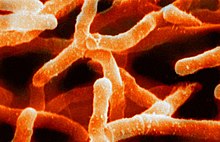Actinobacteria
The Actinobacteria, or Actinomycetota are a group of Gram-positive bacteria. They grow on land or in water.[1] They include some of the most common life forms in soil, playing important roles in the decomposition of organic matter and humus formation. Fungi also play the same role, so some Actinobacteria like Streptomyces were originally classified as fungi. Actinobacteria colonies form branching threads called mycelia. This feature was another reason for the wrongful classification of the actinomycetes, for example, as fungi.
| Actinobacteria | |
|---|---|

| |
| Actinomyces israelii. | |
| Scientific classification | |
| Domain: | |
| Phylum: | Actinobacteria Margulis, 1900
|
| Classes | |
Some species live in a mutual resource exchange with the roots of plants, such as Frankia, while other species can cause disease, such as the genus Mycobacterium and the bacteria Mycobacterium tuberculosis.
Actinobacteria contains one of the largest bacterial genera, Streptomyces, which contributes to maintaining the acidity and basicity levels of the soil.[2] They are also important sources of antibiotics,[3] as well as antifungals,[4] antivirals, and numerous other medicines. They are also very useful in agriculture,[5] as they can be used in insecticides and herbicides, among various other substances.[6] Other Actinobacteria species, such as the genus Bifidobacterium, are commonly found in the intestines of infants[7] and are less common in adults.[8]
Some Actinobacteria found in Siberia or Antarctica are considered the oldest on Earth, frozen around half a million years ago.[9]

References
change- ↑ Servin, J. A.; Herbold, C. W.; Skophammer, R. G.; Lake, J. A. (13 November 2007). "Evidence Excluding the Root of the Tree of Life from the Actinobacteria". Molecular Biology and Evolution. 25 (1): 1–4. doi:10.1093/molbev/msm249. PMID 18003601. Retrieved 2022-07-21.
- ↑ Ningthouja, Debananda S.; Sanasam, Suchitra; Nimaichand, Salam (1 April 2009). "Screening of Actinomycete Isolates from Niche Habitats in Manipur for Antibiotic Activity". American Journal of Biochemistry and Biotechnology. 5 (4): 221–225. doi:10.3844/ajbbsp.2009.221.225.
- ↑ Mahajan, Girish Badrinath (2012). "Antibacterial Agents from Actinomycetes - A Review". Frontiers in Bioscience. E4 (1): 240–253. doi:10.2741/e373. ISSN 1945-0494.
- ↑ Gupte, M.; Kulkarni, P.; Ganguli, B. (1 January 2002). "Antifungal antibiotics". Applied Microbiology and Biotechnology. 58 (1): 46–57. doi:10.1007/s002530100822. PMID 11831475. S2CID 8015426.
- ↑ Bressan, Wellington (2003). "Biological control of maize seed pathogenic fungi by use of actinomycetes". BioControl. 48 (2): 233–240. doi:10.1023/A:1022673226324. S2CID 29320215.
- ↑ Atta, Houssam M. (January 2015). "Biochemical studies on antibiotic production from Streptomyces sp.: Taxonomy, fermentation, isolation and biological properties". Journal of Saudi Chemical Society. 19 (1): 12–22. doi:10.1016/j.jscs.2011.12.011. S2CID 94887557.
- ↑ Turroni, Francesca; Peano, Clelia; Pass, Daniel A.; Foroni, Elena; Severgnini, Marco; Claesson, Marcus J.; Kerr, Colm; Hourihane, Jonathan; Murray, Deirdre; Fuligni, Fabio; Gueimonde, Miguel; Margolles, Abelardo; De Bellis, Gianluca; O’Toole, Paul W.; van Sinderen, Douwe; Marchesi, Julian R.; Ventura, Marco (11 May 2012). "Diversity of Bifidobacteria within the Infant Gut Microbiota". PLOS ONE. 7 (5): e36957. doi:10.1371/journal.pone.0036957. PMC 3350489. PMID 22606315.
- ↑ Pinzone, Marilia Rita; Celesia, Benedetto Maurizio; Di Rosa, Michele; Cacopardo, Bruno; Nunnari, Giuseppe (2012). "Microbial Translocation in Chronic Liver Diseases". International Journal of Microbiology. 2012: 694629. doi:10.1155/2012/694629. PMC 3405644. PMID 22848224.
- ↑ Johnson, Sarah Stewart; Hebsgaard, Martin B.; Christensen, Torben R.; Mastepanov, Mikhail; Nielsen, Rasmus; Munch, Kasper; Brand, Tina; Gilbert, M. Thomas P.; Zuber, Maria T.; Bunce, Michael; Rønn, Regin; Gilichinsky, David; Froese, Duane; Willerslev, Eske (4 September 2007). "Ancient bacteria show evidence of DNA repair". Proceedings of the National Academy of Sciences. 104 (36): 14401–14405. doi:10.1073/pnas.0706787104. PMC 1958816. PMID 17728401.